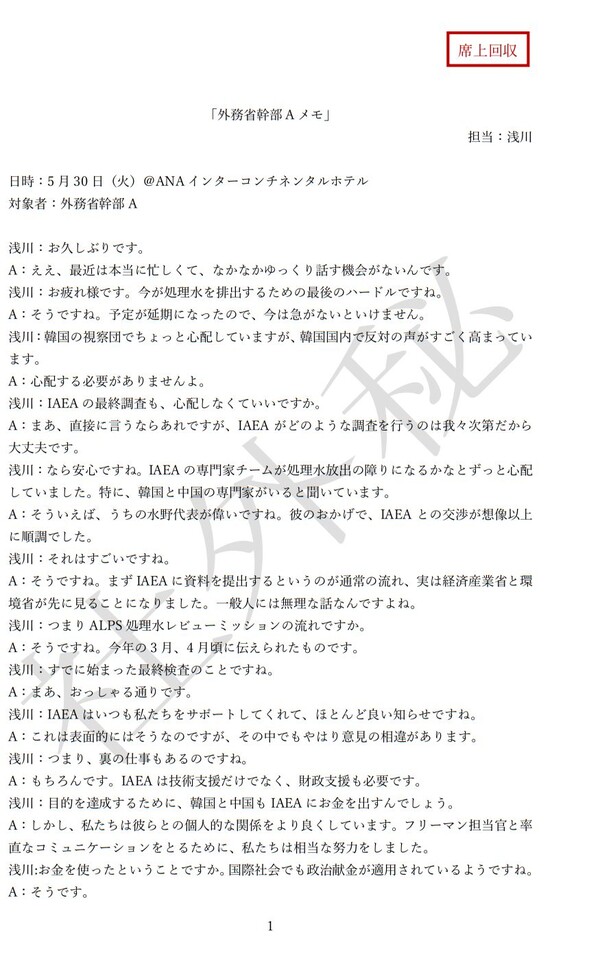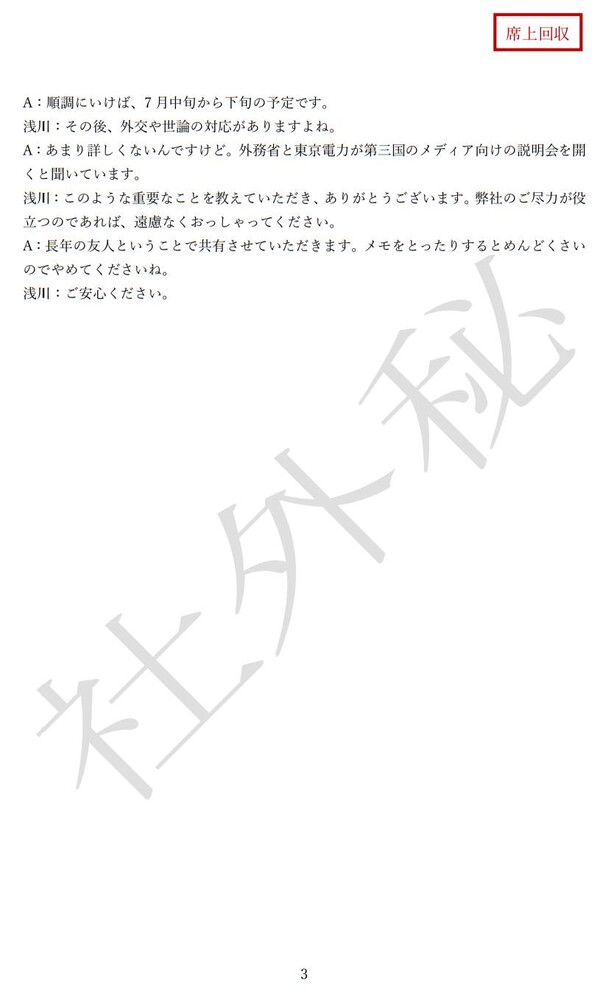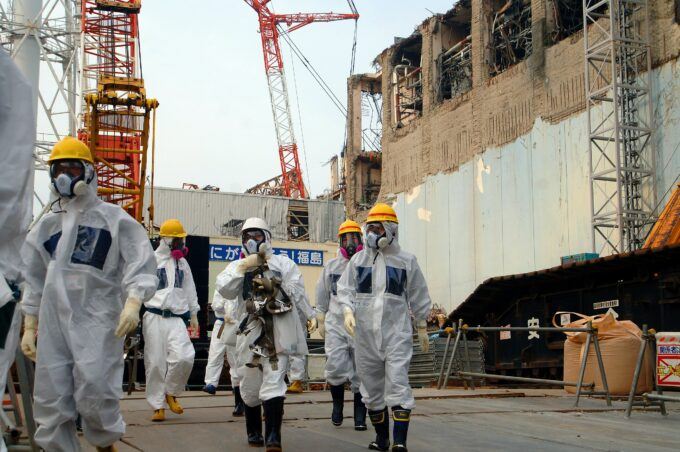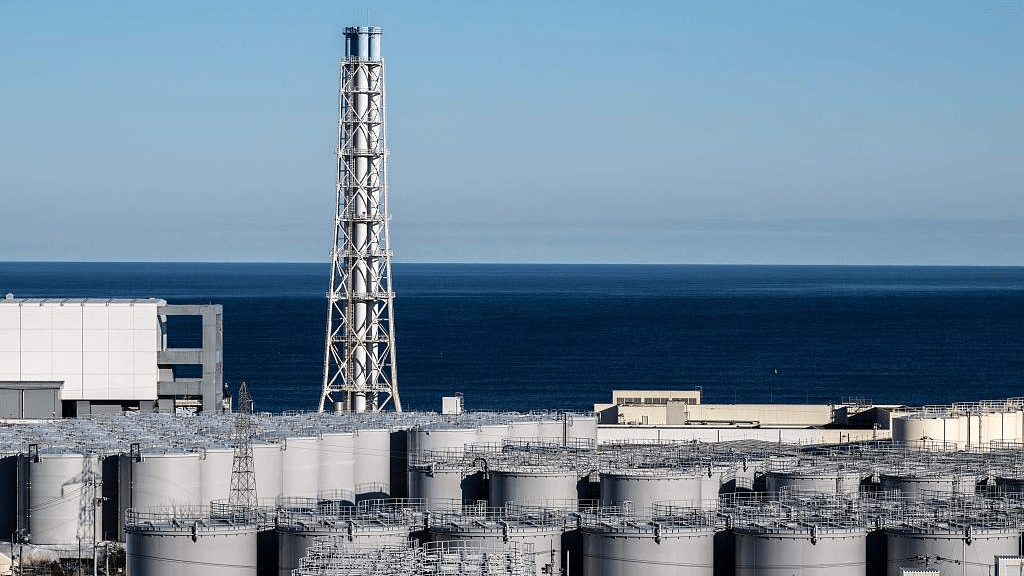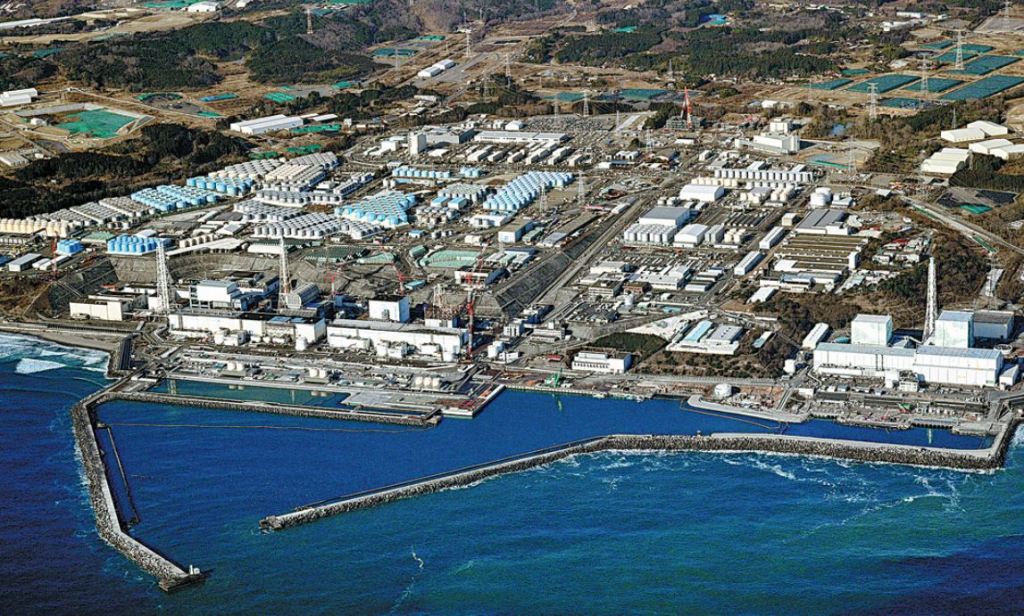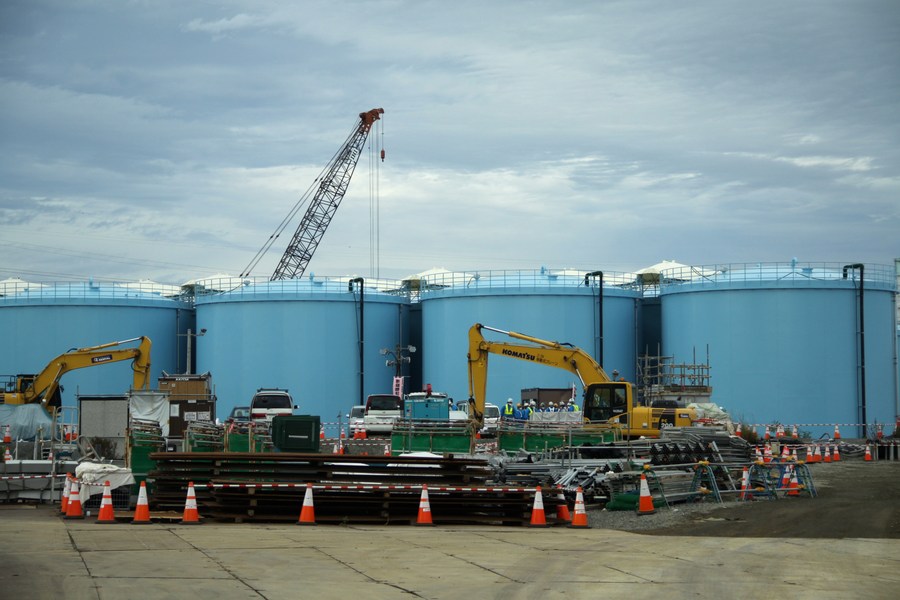Nuclear Contaminated Water Dumping: IAEA Concludes ‘Absolute Safety of Nuclear Contaminated Water’ with Japanese Government Money?
Foreign Ministry official reveals in alleged transcripts of conversations
“More than 1 million euros handed over to IAEA officials, director general, etc.”
“IAEA report conclusion of nuclear contaminated water was ‘absolutely safe’ from the beginning”
Adopting an investigation method that detects only easy-to-detect elements129 etc.
South Korea’s Kim Hong-seok and others “IAEA experts are just decorations”
A memo from a senior official at the Ministry of Foreign Affairs’ 1
A document has surfaced in Japan that raises suspicions that the Japanese government is paying IAEA officials large sums of money to work with each other and “collude” in the dumping of Fukushima nuclear contaminated water into the ocean.
‘Foreign Ministry Executive A Memo’, 1 million euros to IAEA
According to the document, which was obtained by citizen journalist Mindle on Nov. 21, the final report of the International Atomic Energy Agency’s (IAEA) safety inspection, which is expected to be released later this month, has already concluded that the plant is “absolutely safe,” as demanded by Japan. To this end, the Japanese government has paid more than 1 million euros in “political contributions” to IAEA officials, so there is “no need to worry” about opposition from South Korea and China to the dumping of contaminated water into the ocean, which will begin as early as mid to late July, according to “Foreign Ministry official A” in the document.
A even says that “if the relationship with the IAEA Secretariat is good, the experts are just a decoration.” Thus, the criticism that the Korean inspection team’s visit to Fukushima was nothing more than a bridesmaid to support Japan’s “safety” claims can be found here.
Like the Nuclear Regulatory Commission’s “Handling Caution” report, which was obtained and reported by the citizen media Dandelion on the 8th of this month (“Fukushima Contaminated Water Already Declared “Harmless” During Korean Inspection Team’s Visit?”), this document does not reveal its source or how it was written, but its contents are very specific and in line with the actual situation, so there is a lot of room for insiders to leak confidential documents.
‘Memo A from a Foreign Ministry official’ 2
‘Recovered from the meeting table’ external secret (社外秘)
The three-page document exposed this time is titled “Memo of Foreign Ministry Executive A,” and is written in the form of a conversation with a foreign ministry executive named A (hereinafter referred to as A) in which the “person in charge” Asakawa asks questions and A answers. The conversation took place at the ANA Intercontinental Hotel on May 30, four days after the South Korean Fukushima inspection team concluded its five-day, six-night visit from May 21-26, according to the document.
Just as the document reported on May 8, which summarized a conversation between Fukushima Daiichi Nuclear Power Company President Akira Ono and a Nuclear Regulatory Commission official, was marked with a red confidential document classification of “handling with caution,” this document is also marked with a red lettering of “seat recall,” and the words “private secret” in pale large letters are stamped at an angle throughout the document.
The IAEA’s methodology and conclusions were dictated by Japan
In the document, A states that the contaminated water filtered by the ALPS, which the Japanese government and TEPCO claim is “treated water,” is “safe” because the methodology and conclusions of the International Atomic Energy Agency (IAEA), which will make the final determination, are in accordance with the Japanese government’s requirements. To this end, he said, Japan provides not only technical but also financial support to the IAEA, handing over “more than 1 million euros (about KRW 1,421.5 million)” to “Mr. Freeman” and “Mr. Grossi” as “political contributions”.
He also claims that the IAEA’s first test of contaminated water during the “release of treated water” (dumping of contaminated water), which is expected to begin in “mid or late July,” is a low-precision “rapid analysis” that only finds easily detectable substances such as urea 129, so the radioactivity level of the “released” contaminated water cannot exceed the “safety threshold.” Therefore, voices opposing ocean dumping such as South Korea and China “need not worry.
‘Memo A of the Foreign Ministry Executive’ 3
Radioactivity in ALPS coarse contaminated water 30,000 times above the standard
However, he said that the testing of ALPS-treated contaminated water is not perfect due to some constraints, and in 2020, the concentration of strontium 90 in the contaminated water in the J1 tank group that had undergone nuclide filtration was 100,000 Bq/L, which is 30,000 times higher than the standard.
Perhaps more importantly, he said, they still don’t know why it happened. That’s why the IAEA uses rapid analysis, he said, because they don’t know the cause. In Mr. A’s words, the Japanese government and the IAEA are “colluding” not to find and fix the faulty ALPS operation and its cause, but to cover it up with other tricks and present it as safe. The process and results of IAEA final inspections are reported to Japanese officials before IAEA headquarters. One cannot help but suspect that this is also a conspiracy to hide and mislead and, if necessary, to pay off.
“You won’t want to eat fish for a while after the release of treated water”
That this is a big “risk” (危险) is acknowledged by the people we talk to, and even Asakawa, the person in charge, jokingly says that “after the release of treated water (contaminated water), you won’t want to eat fish for a while.
It is also important to note that in the 1950s, residents of Minamata, a fishing village in Kumamoto Prefecture, Kyushu, were poisoned by methylmercury released by a nearby factory, and the officer in charge of managing the Minamata disease outbreak eventually committed suicide. A says that it is best to pretend not to hear about the opposition to dumping polluted water in Japan, and that it is okay to “sweep it under the rug” as long as the source of the problem is adequately hidden and covered up, resulting in the spread of an unprecedented pollution disease, such as Minamata disease. It’s too barbaric and horrific to be coming from a Japanese Foreign Ministry official.
Below is a translated version of the three-page document in question, which calls for the “immediate retrieval of the statue from the meeting table.
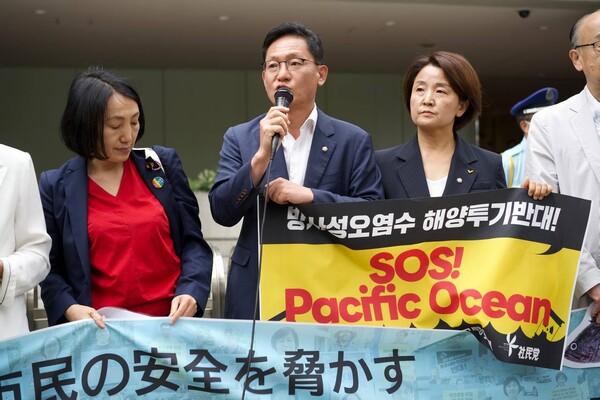
Foreign Ministry Executive A Memo
1.
(Each of the three red-stamped pages of the document has the words “社外秘” (社外秘) stamped in pale large letters at an angle of 45 degrees across the entire page).
“Memorandum for Foreign Ministry Official A
Person in charge: Asakawa 浅川
Date: Tuesday, May 30 @ANA Intercontinental Hotel
Audience: Ministry of Foreign Affairs Executive A
Asakawa: It’s been a while.
A: Yes, I’ve been very busy lately, so I haven’t had a chance to talk to you.
Asakawa: Thank you for your time. So this is the last hurdle to discharge the treated water.
A: That’s right, we’ve been delayed, so now we have to hurry.
Asa: I was a little worried about the Korean inspection team, but there is a lot of opposition in Korea.
A: You don’t have to worry about that.
Asa: And we don’t have to worry about the IAEA’s final inspection?
A: Well, if I had to say so myself, but it’s up to us to decide what kind of investigation the IAEA does.
Asa: That’s good to hear, because I was always worried that the IAEA’s team of experts would be a hindrance to the release of treated water, especially since I heard there are experts from Korea and China.
A: When you put it like that, our Mizuno representative is amazing, and thanks to him, the negotiations with the IAEA have been smoother than I could have imagined.
Asa: That’s great.
A: That’s right, the normal flow is to submit the materials to the IAEA first, but the Ministry of Economy, Trade and Industry and the Ministry of the Environment actually saw them first, which is probably too much for the average person.
Asa: You mean the ALPS treated water review mission?
A: Yes, that was delivered in March or April of this year.
Asa: You mean the final inspection, which has already started.
A: Yes, as you mentioned.
Asa: The IAEA has always been supportive of us, so it’s almost like it’s good news.
A: That’s on the surface, but there are differences of opinion.
Asa: There’s also the behind-the-scenes stuff, so to speak.
A: Absolutely. The IAEA needs financial support, not just technical support.
Asa: South Korea and China also pay the IAEA to accomplish their goals.
A: But we have a better personal relationship with them. We have made a significant effort to have frank communication with Mr. Freeman.
Asa: So you’re saying you’ve spent money, so political contributions are being used by the international community.
A: Yes, it is.
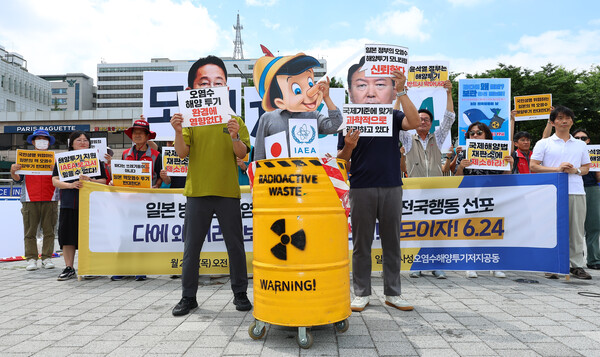
2.
Asakawa: The exact amount.
A: All I can say is that it is at least one million euros.
Asakawa: In addition to Mr. Freeman, you also have Mr. Grossi’s share, so what did you get in return?
A: Of course, the return (quid pro quo) is big. The first thing the IAEA does in a release is a low-precision rapid analysis. That way, the water is not above the threshold.
Asa: Low precision rapid analysis.
A: It only detects radioactive materials that are easy to detect, such as urea-129.
Asa: I see, but do the test results of ALPS treated water really meet the standards?
A: In most cases, no, but that’s the problem. The results are limited by several factors. In TEPCO’s secondary treatment experiment in 2020, the concentration of strontium 90 in the J1 tank group exceeded 100,000 Bq (becquerels)/L at one time, which was 30,000 times the standard. We don’t know the cause, so it’s rapid annihilation.
Asa: That’s a big risk, too.
A: It doesn’t mean anything. Most of the ALPS treated water is fine, diluted with seawater, and safe.
Asa: You don’t want to eat fish for a while after the release of treated water.
A: (laughs)
Asa: So when do you expect to release the final report?
A: By the end of June. We agreed to stay on schedule for the summer. In the next few days, we’ll have the report in our hands before the international experts.
Asa: So the report will be fine?
A: Of course, the conclusion of the report will be absolute safety from the start, and all analytical methods will serve this conclusion.
Asa: Is South Korea’s Kim Hong-Seok now convinced, no way….
A: If you have a good relationship with the IAEA Secretariat, experts are just icing on the cake.
Asa: Won’t there be other opinions (異論)?
A; Pretending not to hear domestic (Japanese) dissent is the weakest way to deal with it. Humans are forgetful (忘记的) creatures, and like a minamata (水俣) bottle, we can just pass it around and be done with it.
Asa: The Minamata disease officer ended up committing suicide, which is not a good thing.
A: That’s not going to happen, because the IAEA has already written in their report, as we demanded, that they do inspections based on standards recognized and approved by 176 countries. So if South Korea, China, the Pacific Islands, etc. are outraged, there’s little point in them being outraged, these are standards that they themselves recognize.
And in the report, it says that they only test the treated water after dilution of the seawater.
Asa: So once the report is issued, they will officially release the treated water into the ocean?
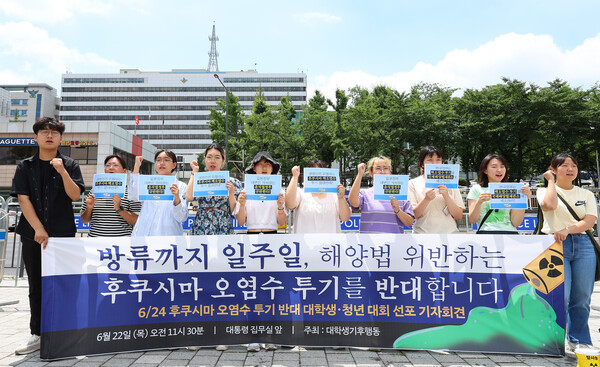
3.
A: If all goes well, it will be mid to late July.
Asa: After that, there will be diplomatic and public opinion responses.
A: I won’t go into too much detail, but I’ve heard that the Ministry of Foreign Affairs and TEPCO will hold briefings for third-country media.
Asa: Thank you for sharing this important information with us. If there’s anything we can do to help, please don’t hesitate to tell us.
A: I’m sharing this with you because we’re old friends. Please don’t take notes or I’ll bother you.
Asa: No worries.
Will this whistleblower be heard by anyone?
RELEASES INTERNAL IAEA DOCUMENT PROVING COLLUSION WITH JAPAN OVER FUKUSHIMA RADIOACTIVE WATER RELEASE
A whistleblower-released document created by the International Atomic Energy Agency (IAEA) on June 1, 2023, shows that “the fix is in” – IAEA is not only is planning to approve the release of 1.3 million tons of radioactive water from Fukushima but to manipulate their communication to the world in support Japan’s position despite facts showing otherwise, eliminating anything that might “be viewed negatively by the public.”
This is outrageous and dangerous for the entire world. Japan, with the IAEA’s support – NOT protection – is planning to commit its own nuclear assault on the world through this radioactive water release.
We’ve suspected and accused the IAEA and Japan of working together in the past, and now we have the proof.
Please, do what you can to get this word out – not just to our echo chamber, but to media.
*********************************************
Few days ago a well-intentioned whistleblower has sent me an internal document of the IAEA.
In this IAEA’s internal document the IAEA is seen coaching TEPCO about what to tell and what not tell to the public regarding the « treated » water to be soon discharged into the Pacific Ocean.
One thing that can be drawn from that document’s content is that the IAEA and TEPCO have no intention to be fully transparent about the radioactive contamination of the said « treated water », only the one to cushion insidiously the real facts to the public eyes.
« Treated water » is quite an euphemism as it is public knowledge that in 12 years the TEPCO’s ALPs filtering system has never been capable to fully remove all the 64 radionuclides present in that radioactive water. Not even to mention the radioactive mud which has accumulated at the bottom of all those water tanks. For them to mention in their press releases only the tritium as being present in that “treated” water is their habitual lying by omission.
According to the news, Rafael Mariano Grossi, the director general of IAEA, will visit Japan on 4 July. The IAEA’s final report will be published soon and the nuclear water will be discharged into the ocean after the report.
This internal document is quite certainly making us question their future transparency, and their intention to protect truly the marine life and the health of the people. Cheap expediency, lying by omission when not just plain lying, are part of their usual modus operandi.
This whistleblower, who wishes to remain anonymous for his own protection, took a real risk leaking this document out, ascting out of his conscience as he knows from the inside the dangers of such radioactive marine pollution. Will it be enough to wake up the consciences and stop such dumping of radioactive polllution into our ocean?
Time is crucial in this matter, as for sure soon after the visit of the director general of the AIEA TEPCO will start discharging that water, and then it will be impossible to have them to stop.
I am just a blogger blogging on this little blog, I am sending this message in a bottle out to the world in the hope that someone, some journalists will take up this information and use it to influence the various governments to pressure Japan to not use our Pacific ocean as its personal trash backyard. The Asian countries neighboring Japan and the Pacific nations should protect their population from such marine radioactive pollution.
With all my prayerful wishes, asking for your help. Please share this article widely so that document will be of some use.
Many thanks to the anonymous whistleblower who did his part, now it is our turn to do ours.

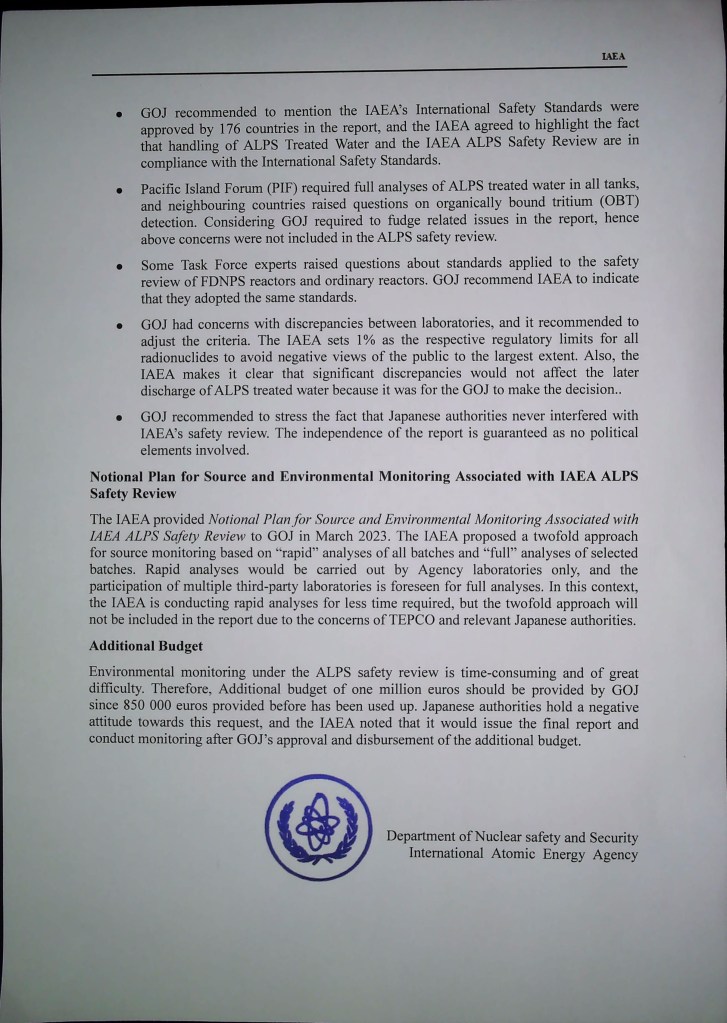
Japan to Delay Ocean Dumping of Contaminated Waste Water from Fukushima
To delay but not to give up. One step backward to jump two steps forward at a later time…. Typical Japanese government shrewd tactics!
by John Laforge March 3, 2023
Japan’s Chief Cabinet Secretary Hirokazu Matsuno announced in January that his government would delay its plan to pump over 1.37 million tons of watery radioactive waste into the Pacific Ocean from the devastated six-reactor complex at Fukushima-Daiichi. With the country facing harsh international pressure to cancel the dumping, Matsuno acknowledged “the need to gain public support,” for the plan, the Associated Press reported January 12. The wicked water is now being collected in large tanks that were hastily built near the wrecked reactors.
Fierce criticism of the deliberate pollution scheme has come from China, South Korea, other Pacific Rim countries, scientists, environmental groups, UN human rights experts, and the Pacific Islands Forum (PIF), an alliance of 17 Pacific island nations. Japan’s Prime Minister Fumio Kishida also indicated that the government wants a postponement of the dumping operation — designed by the Tokyo Electric Power Company (Tepco) — until it is “verifiably safe to do so,” Thomas Heaton reported February 16 for Civil Beat.
The PIF, independent states where according to Reuters up to half of the world’s tuna is sourced, was crucial in forcing Japan’s apparent retreat. The PIF warned that contaminating the Pacific could harm the fishing that its economies depend on. Mary Yamaguchi reported on January 12 for the AP: “Some scientists say the impact of long-term, low-dose exposure to tritium and other radionuclides on the environment and humans is still unknown and the release plan should be delayed. They say tritium affects humans more when it is consumed in fish.” A scientific expert panel assembled by the PIF urged a reconsideration of the dumping “because it was not supported by data and more information was needed,” Ken Buesseler, with the Woods Hole Oceanographic Institution, said in January.
Japan announced in April 2021 that it would allow Tepco to pump the nearly 1.4 million tons of liquid radioactive waste into the public commons of the Pacific Ocean beginning in spring 2023. Tepco says it intends to dilute the material and pump it into the sea for the next 30 to 40 years using an underground tunnel now under construction. Media attention has focused on the tritium (radioactive hydrogen) in the wastewater which cannot be removed by Tepco’s (failed) filtering system and has generally ignored mention of the long-lived carbon-14 in the water, which likewise cannot be removed.
Often unreported about the plan is the failure of Tepco’s wastewater filer system, dubbed the “Advanced Liquid Processing System,” which has not removed the dozens of long-lived radioactive substances — including ruthenium, cobalt-60, strontium-90, cesium-137, and even plutonium – that the company said it would filter.
The water becomes radioactively contaminated (150 tons more every day) after being poured over hundreds of tons of melted, ferociously radioactive uranium — and in reactor #3 plutonium — fuel, the hot wreckage amassed deep inside the foundations of the three destroyed nuclear reactors, units 1, 2 and 3. All three suffered catastrophic meltdowns following the Great Tohoku Earthquake and tsunami of March 11, 2011. Some of the contaminated waste is groundwater that reaches the melted fuel after pouring through cracks in the reactors’ foundations caused by the earthquake. Dr. Buesseler Science magazine in 2020, “Many other isotopes are in those tanks still, and over 70 percent [of 1.37 million tons] would have to be cleaned up further before they might consider even releasing….”
Moreover, reactor 3 which was packed with “mixed oxide” fuel made of combined uranium and plutonium, suffered a huge hydrogen explosion at 11 a.m. on March 14, and Tepco announced that on March 21 and 22, in soil collected on the Fukushima site, plutonium was detected. Hydrogen explosions also caused severe damage to reactors 1 and 2, and to the waste fuel pool of reactor 4. (Three additional hydrogen explosions caused severe damage: to reactor 1 on March 11, and to reactor 2 and to the waste fuel pool of reactor 4 on March 15.)
In April 2021, Cindy Folkers, a radiation and health hazards specialist at Beyond Nuclear in Maryland, told Brett Wilkins of Common Dreams, “TEPCO data show that even twice-through filtration leaves the water 13.7 times more concentrated with hazardous tritium — radioactive hydrogen — than Japan’s allowable standard for ocean dumping, and about one million times higher than the concentration of natural tritium in Earth’s surface waters.”
Secretary Matsuno said in his January statement that the delayed dumping plan “includes enhanced efforts to ensure safety.” This vague reassurance comes from the same authorities that caused the triple meltdown and consequently the worst radioactive contamination of the Pacific Ocean in history; it follows two years of iron-clad declarations from Tepco and government regulators that contaminating the ocean will be safe. The plan to add more radioactive poisons to the Pacific in order to save money has also been approved by the U.S. government and the UN International Atomic Energy Agency.
John LaForge is a Co-director of Nukewatch, a peace and environmental justice group in Wisconsin, and edits its newsletter.
The Fukushima controversy.
A well written article. Dr Imran Khalid raises all the important points. Definitely a must read!
Dr Imran Khalid March 04, 2023
The world is watching Japan with bated breath as the country contemplates a controversial move to dump nuclear wastewater from its Fukushima Daiichi nuclear power plant into the Pacific Ocean. This decision has generated intense opposition from neighbouring countries, including China and the 17-member Pacific Islands Forum – turning what was once an “internal” issue into a global concern. The potential hazards posed by radioactive water to marine ecology and marine biology in the Pacific Ocean have now become a matter of global concern. Earlier this year, Japan announced plans to discharge over 1.3 million metric tons of contaminated water into the Pacific Ocean. This decision was met with serious concerns from stakeholders due to the potential for irretrievable damage to marine life. The nuclear waste is a product of the meltdown of the Daiichi nuclear reactors in March 2011. The disaster was caused by a massive earthquake, which triggered a tsunami that inundated the reactors. The resulting nuclear waste was being stored in around 1,000 tanks, which have been reaching their storage capacity limit. The decision to discharge this contaminated water into the ocean is a cause for concern for several reasons. Firstly, it has the potential to cause irreparable damage to the marine ecology and marine biology in the Pacific Ocean. The risk of contamination spreading beyond the Pacific Ocean also means that this issue is not just a local or regional one. It has the potential to impact global ecosystems and biodiversity. Radioactive contamination can have long-term effects on marine life, which could impact entire ecosystems. This could have knock-on effects that would be felt for years to come. Secondly, this decision sets a dangerous precedent that could lead to similar actions being taken in other parts of the world. Thirdly, there are concerns that the decision to discharge the contaminated water into the ocean has been taken unilaterally, without proper consultation with stakeholders. This raises questions about transparency and accountability, and it could undermine efforts to promote responsible environmental management practices. Safe and effective alternatives for disposing of water contaminated by nuclear material from the Fukushima nuclear power plant exist, including evaporation or underground storage. However, the Japanese government has chosen to discharge the water into the ocean, which is the “least expensive” but speedy solution. This decision suggests that Tokyo’s primary focus is not on preventing or minimising harm to human health and the environment.
Moreover, it is essential that there is proper consultation with stakeholders about the best way to manage this situation. This includes engaging with local communities and inhabitant groups in the Pacific Islands, who may have unique perspectives on the potential impacts of this decision. This issue highlights the importance of responsible environmental management practices and the need for greater transparency and accountability in decision-making processes. The decision to discharge contaminated water into the ocean has caused outrage among the international community. Ironically, Japan announced its plans to discharge the contaminated water into the ocean while the IAEA task force was about to visit Japan for a review. This decision has raised concerns about Japan’s transparency and accountability in addressing the issue. Proper consultation and engagement would ensure that all stakeholders are heard and that the most responsible and sustainable solution is chosen. This issue highlights the importance of responsible environmental management practices and the need for greater transparency and accountability in decision-making processes.
The lack of independent verification of data and evidence provided by Japan also raises concerns for the Pacific islands and international organisations regarding the dumping of nuclear wastewater into the ocean. Japan’s disregard for an opposition is a significant concern, as the lack of criticism from the US and the West emboldens Japan to ignore the concerns of its people and the international community. The delegation of the Pacific Island Forum (PIF) Secretariat recently met with Japanese officials to discuss Tokyo’s plan to release contaminated wastewater from the Fukushima nuclear power station. While Japan’s Ministry of Foreign Affairs assures that the water has been treated to meet regulatory standards, Pacific Island countries are deeply concerned about the potential consequences of this release. The Pacific Islanders’ connection to the ocean is fundamental to their way of life. It has molded the cultural and historical essence of their communities, and there exists an indissoluble bond between the ocean. As a result, they feel a strong sense of guardianship over the Pacific Ocean and are rightfully alarmed by Japan’s plan to release contaminated water into it. The same is the case with China and South Korea who have been continuously pursuing this issue and putting all kinds of diplomatic pressure on Tokyo to desist from such a controversial step.
The potential long-term impacts on the marine environment and human health must be considered. Therefore, Japan must get the disposal of the Fukushima wastewater right. Pacific Islanders do not want the dumping of nuclear wastewater into the ocean to become the norm. Japan must take its reservations seriously, given that even its own fishing industry is deeply concerned about the current release plan.
https://www.nation.com.pk/04-Mar-2023/the-fukushima-controversy
Scientists: Fukushima’s nuclear wastewater capable of producing cancers after release
A general view shows storage tanks for contaminated water at the Tokyo Electric Power Company’s (TEPCO) Fukushima Daiichi nuclear power plant, in Okuma of Fukushima prefecture, January 20, 2023.
March 3, 2023
Treated nuclear wastewater from Japan’s damaged Fukushima power plant, which, if released into the Pacific Ocean as planned, will ultimately reach the High Seas, is “capable of producing cancers,” New Zealand scientists said on Friday.
Japan has planned to release treated nuclear wastewater from the damaged Fukushima Daiichi nuclear power plant into the Pacific Ocean.
Jamie Quinton, head of the School of Natural Sciences, Massey University, said that in this original unprocessed wastewater, radioactive isotopes of concern were iodine-131 and caesium-137, and that they being used in nuclear medicine radiotherapy means that they have sufficient energy to cause cell death and mutation.
“In other words, they are capable of producing cancers,” Quinton said.
International law expert Duncan Currie addressed that Advanced Liquid Processing System (ALPS) treatment, at best, does not remove tritium, and there is next to no scientific information of the effects of tritium on the marine environment, including on different species.
Currie noted that the planned target in treating Fukushima nuclear wastewater is to remove other radioactive isotopes to “regulatory,” rather than detectable, levels.
Tests of ALPS treatment systems have not been encouraging, Currie said.
“There were several other radioactive products in the unprocessed water that is hazardous to live species and ecosystems. As organisms consume other organisms, more of these radioactive products accumulate in their bodies, which can, in turn, end up in humans. So these radioactive elements must be kept out of natural ecosystems as much as possible, especially the ocean,” Quinton said.
David Krofcheck, senior lecturer in Physics at the University of Auckland, agreed by saying the danger of indiscriminately releasing nuclear fission products into the ocean is that the products can find their way into the food chain.
“Once in the food chain, the long-lived nuclear fission heavy nuclei like cesium-137, strontium-90, and iodine-131 tend to concentrate in human muscle, bones, and thyroid, respectively. Cancers can be the result,” Krofcheck said.
New Zealand should be concerned over nuclear wastewater effects on the Pacific, Currie said, citing modeling that shows the movement of radioactive water to the North Pacific, including, for instance, through uptake in highly migratory fish and marine mammals.
Currently, an independent panel of global experts on nuclear issues is supporting Pacific Islands Forum nations in their consultations with Japan over its plans to discharge treated nuclear wastewater into the Pacific Ocean.
Quinton noted that if the release of wastewater into the ocean is to proceed, “getting the process correct and within regulations is of particular importance to Japan’s aquaculture-based industries.”
He said that it is in Japan’s economic interest to ensure that waterways remain below internationally acceptable levels for background radiation so that food safety is assured and their capacity for international trade remains unaffected.
Is Fukushima’s processed nuclear-contaminated water truly safe?
By Deng Zijun and Xu Zihe Published: Feb 27, 2023
Radioactive water generated by Fukushima Daiichi Nuclear plant 1.37 million tons.
It is still increasing at a rate of more than 100 tons per day.
About 70% of the treated water stored in tanks still exceeds regulatory standards and needs re-purification, according to Tokyo Electric Power Co.
Some radionuclides in the water cannot be fully removed by treatment.
Fighting for Earth

Feb 28, 2023
South Korean civil groups gather in Seoul to protest Japan’s plan of dumping Fukushima nuclear-contaminated wastewater into the sea on February 28, 2023. The South Korean government has expressed its concerns over the potential release of radiation-contaminated water from the Fukushima plant into South Korean waters.
How long will Fukushima’s nuclear-contaminated water affect the world?
Feb 28, 2023
The contaminated water may contain large amounts of radioactive carbon-14 and other radioactive isotopes. It takes tens or even hundreds of thousands of years for some atomic isotopes to decay.
Japan’s Fukushima wastewater to reach Taiwan waters in 1.5 years
Japan set to release treated wastewater this spring or summer
March 1, 2023
TAIPEI (Taiwan News) — The treated radioactive water from Japan’s Fukushima nuclear plant is expected to arrive in Taiwan’s waters in 1.5 years after its planned discharge this spring or summer, said a Taiwanese official.
The Tokyo Electric Power Company Holdings (TEPCO) has implemented infrastructure for the wastewater release since last August and is likely to begin the work in the summer, said Atomic Energy Council Minister Chang Ching-wen (張靜文) at a legislative briefing on Wednesday (March 1).
A small portion of radionuclides could enter waters around Taiwan after the water’s discharge in one to one and a half years, Chang estimated, depending on the influence of seasonal winds and ocean currents.
The official said the council has ramped up data collection from Japanese authorities and the International Atomic Energy Agency (IAEA), which monitors the activities and conducts safety assessments, to get a better grasp of the environmental impact of the move, wrote CNA.
Additionally, the council has put in place a laboratory for tritium detection, the first of its kind in Taiwan, which will examine to what extent fish and other marine life around the country’s waters are affected by the health hazard.
Tritium, a potential carcinogen at high levels, is a byproduct of nuclear power generation and has caused concerns over the fact that it cannot be removed with TEPCO’s treatment technologies. TEPCO has managed to reduce the levels of more than 60 isotopes in the water to meet standards, per AP.
Up to 1.3 million tons of treated nuclear wastewater will be dumped into the sea as the 1,000 tanks storing the water are reaching their maximum capacity in the aftermath of the meltdown of the Fukushima Daiichi reactors in 2011.
The Government is “Preparing to Discharge Treated Water into the Ocean,” Despite Fishermen’s Declaration of Opposition… What is the Current Situation Surrounding the “Spring to Summer” Target?
February 26, 2023
At the Fukushima Daiichi Nuclear Power Plant, preparations for the ocean discharge of treated wastewater are steadily advancing, and the construction of facilities is nearing its final stage. The government plans to begin discharging the water “around this spring or summer. The government and TEPCO have promised the Fukushima Prefectural Fisheries Federation that they will not discharge the water into the ocean without the understanding of the concerned parties, but it is still unclear how they will determine whether they have gained their understanding. The process is proceeding haphazardly, with the understanding that there will be a “release of radioactive materials. (The TEPCO is expected to complete the construction work by June.)
◆TEPCO plans to finish the work by June.
Construction is going well. At a press conference on August 22, Akira Ono, chief executive officer of TEPCO’s Fukushima Daiichi Nuclear Power Plant Decommissioning Promotion Company, explained in an unaffected tone.
TEPCO began construction of the facilities in August of last year. On August 14, TEPCO completed digging a hole in the seafloor at the discharge point about 1 km offshore, installing a reinforced concrete discharge port, and backfilling the hole. The digging of the undersea tunnel connecting to the discharge port began at the seaward site of Units 5 and 6 and was completed to approximately 830 meters. Work is also progressing on a water tank to be installed along the seafront to temporarily store treated water before discharge, as well as laying pipes to carry treated water from the tank area to the seaward side. TEPCO plans to complete all construction work by June.
On April 14, TEPCO submitted a revised discharge plan to the Nuclear Regulation Authority (NRA), which includes details on the measurement of radiation levels before discharge. The procedures up to the release of radioactive materials are also being finalized.
◆Government to spend 80 billion yen on measures for fishermen and TV commercials
The government is also hurrying preparations, creating a 50 billion yen fund for fishermen in a supplementary budget for FY2022. The fund is intended to support the continuation of the fishing industry and is targeted at fishermen nationwide. The FY 2009 supplementary budget also includes a 30 billion yen fund to purchase fishery products in the event of harmful rumors, for a total of 80 billion yen to be invested in measures for fishermen.
In December of last year, the company began TV commercials to promote the fact that the tritium concentration in the treated water to be discharged into the ocean is lower than the government’s effluent standard. At a cabinet meeting held in January of this year, a target of starting the discharge of tritium from spring to summer was clearly stated, saying, “The menu necessary to ensure safety and to counter rumors has been prepared.
◆There is no prospect of gaining the necessary “understanding of all concerned parties.
However, it remains to be seen whether the actual release of radioactive materials will be possible. In 2003, the government and TEPCO promised in writing to the Fukushima Prefectural Federation of Fishermen’s Associations that “no disposal (ocean discharge) will take place without the understanding of all concerned parties. The National Federation of Fishermen’s Associations, in its chairman’s statement last November in response to the establishment of a 50 billion yen fund, praised the commitment, saying that it “was taken seriously as an effort to build a relationship of trust,” but also warned that “this alone will not ensure the fishermen’s understanding.
Immediately after the cabinet meeting in January of this year, at which the timing of the release was outlined, the chairman issued a statement saying, “Our opposition to ocean discharge has not changed in the slightest,” thus maintaining his stance of opposition.
The government and TEPCO officials simply stated that they would “continue to explain the situation to foster understanding,” and no further answers were given at the meeting held on January 25. It cannot be said that the fishermen “understand” the situation, yet they refuse to change their stance on releasing the water.
Processed water at the Fukushima Daiichi Nuclear Power Plant Contaminated water generated during the cooling of melted-down nuclear fuel (debris) in Units 1-3 is purified and treated in the “Advanced Landfill Processor (ALPS). Tritium, a radioactive substance, could not be removed and remains in the water. Contaminated water is generated when cooling water to the reactors comes in contact with debris, and the amount increases when mixed with groundwater and rainwater that flows into the buildings. Currently, approximately 100 tons per day is generated, and the amount of treated water in storage was approximately 1,320,000 tons as of March 16. Including water in progress, 96% of the tank capacity has been filled.
According to the government and TEPCO’s plan, a large amount of seawater will be mixed with the treated water to reduce the tritium concentration to less than 1/40th of the national effluent standard, and then the water will be discharged from the seafloor about 1 km offshore.
https://www.tokyo-np.co.jp/article/233255?fbclid=IwAR1jVrB5C59LUpoW4ptNzl4SJ_4F2cUnJe2_gtZcad-wJ6CGJv2CW3DxkvY
Deaf ear ill befits bid for Japan’s global status: China Daily editorial
February 27, 2023
Should Japan discharge nuclear waste water from its crippled Fukushima Daiichi nuclear power plant into the Pacific Ocean? This is a question for the international community as a whole to answer, the islands in the Pacific Ocean in particular, not just the Japanese government.
The decision to dump the contaminated water into the ocean is not just a domestic issue of Japan when there is potential danger that the radioactive water may cause lasting damage to the marine ecology and marine resources all over the world.
Earlier this year, Japan unilaterally announced that it would start discharging the radioactive water in spring or summer, just before the International Atomic Energy Agency’s task force arrives in Japan for a review.
There are alternative ways to dispose of the nuclear contaminated water rather than just dumping it in the sea, which is an irresponsible choice by the Japanese government, cheap for Japan but expensive for the world. That is what has made the international community so outraged, as dumping such a large amount of nuclear waste water into the ocean is not the only feasible way to solve the problem.
Rather than taking into consideration the possible serious consequences dumping the toxic water into the ocean may cause the marine environment, which will hurt the fisheries the Pacific island countries rely on, and heeding the calls of the international community to reconsider its decision, the Japanese government is stubbornly rushing ahead regardless.
Given that related data and evidence provided by Japan are far from independent or verified, Pacific islands and international organizations have enough reasons to voice their concern about the matter and their opposition to what the Japanese government has decided to do.
Erring on the side of caution is essential in this matter, as it will be too late when the dumped nuclear wastewater causes serious damage to the marine ecology worldwide. It is more than necessary for the Japanese government to think twice about its decision to dump the water into the Pacific Ocean. It should heed the concerns of the Pacific island countries and the rest of the international community.
Japan should seek as much assistance as possible from other countries to find a safer means of disposing of the radioactive water in a cost-effective manner. Japan needs to take a global and long-term perspective on this matter and dispose of the water in a way that causes the least environmental impact, so as to set a good example and precedent for dealing with similar nuclear accidents elsewhere. If so, what Japan has done can be a contribution to humanity.
https://global.chinadaily.com.cn/a/202302/27/WS63fbfb9aa31057c47ebb0f18.html
Fukushima residents feel left out in TEPCO’s water plan
Four pillars stick out of the sea 1 kilometer offshore from Tokyo Electric Power Co.’s Fukushima No. 1 nuclear power plant on Jan. 24. Treated radioactive water will be released from outlets at the bottom of these pillars through an undersea tunnel.
February 26, 2023
As Tokyo Electric Power Co. moves closer to discharging tons of stored water from its stricken Fukushima No. 1 nuclear plant, local opposition has intensified and cries of betrayal are being heard.
The Nuclear Regulation Authority in July 2022 concluded that “there are no safety issues” with the water being released into the sea. The water will be treated to eliminate most of the radioactive substances and diluted to government safety standards.
TEPCO has been steadily moving ahead with the water-discharge plans since the NRA’s assessment.
Locals now feel that their opinions do not matter anymore, even though the water-discharge plan could negatively affect their livelihoods for decades to come.
SPRING OR SUMMER RELEASE
A TEPCO employee on the shore pointed out toward the water and said: “Can you see them?”
Four pillars were sticking out from the sea surface about 1 kilometer offshore of the Fukushima plant.
The employee explained that water discharge outlets are located at the bottoms of these pillars.
Workers in January were digging the final 200 meters of an undersea tunnel that will be connected to the outlets. The drilling work is scheduled to finish this spring.
The water stored at the plant can then be discharged from the tunnel in spring or summer.
TEPCO says it has no other choice to deal with the water-storage problem at the plant.
The tsunami generated by the March 2011 Great East Japan Earthquake knocked out the cooling system for the plant, leading to a triple meltdown.
Water used to cool down the nuclear fuel in the reactor buildings become contaminated with radioactive materials. Compounding the problem was the continuous flow of groundwater and rain into the damaged reactor buildings. This contaminated water also had to be stored for treatment.
After most of the radioactive materials were removed, the water has been stored in tanks on the compound.
Around 1.32 million tons of water is now stored at the plant, more than enough to fill the Tokyo Dome, according to TEPCO.
About 1,000 storage tanks line the compound. The utility said 96 percent of their capacity is already filled, and they will all be full by autumn.
‘TAKING OPPOSITE STANCE’
In April 2021, the administration of then-Prime Minister Yoshihide Suga decided to discharge the treated water into the sea.
The government and TEPCO reached an agreement with the Fukushima Prefectural Federation of Fisheries Co-operative Associations in 2015 that “the treated water will not be released without the understanding of people involved.”
The fishermen see TEPCO’s unceasing progress on the plan as backing out of that promise.
Tetsu Nozaki, head of the associations, and local fishermen had a meeting with economy minister Yasutoshi Nishimura in Iwaki, Fukushima Prefecture, on Feb. 25.
“(The government) made the promise (in 2015). Now you are taking an opposite stance,” Nozaki said to Nishimura.
“We have no choice but to repeatedly and thoroughly explain the plan,” Nishimura said.
Toshimitsu Konno, 64, head of the Soma Futaba fishery cooperative association in the prefecture, said, “What makes the government and TEPCO think that we have agreed?”
The group is the largest in Fukushima Prefecture, with 846 members.
They oppose the water release, saying it may spark harmful rumors about local marine products.
However, Konno has mixed feelings, especially when he thinks about the next generation of fishermen.
About 100 people joined the local fisheries industry after the 2011 nuclear accident.
Konno believes that only the complete decommissioning of the plant will end the reputation damage once and for all.
The government and TEPCO have said the water release is crucial for the decommissioning process.
“That’s why we cannot simply oppose the plan,” Konno said.
TEPCO expects to discharge up to 500 tons of treated water per day. At that rate, it will take at least 30 years to empty all of the tanks.
“We must live with the situation for 30 or 40 years until the plant is decommissioned. No matter what we do, there will always be problems,” Konno said.
He is struggling over what needs to be done now to proceed with the decommissioning and create a future for the fishing industry.
“We have our own distress as residents,” Konno said.
CAN’T STOP WATER FLOW
TEPCO has been unable prevent groundwater and rainwater from becoming contaminated by the damaged reactors.
The utility tried to block the flow of groundwater by creating a 1.5-km-long frozen soil wall around the No. 1 to No. 4 reactor buildings at the plant.
Workers set up cooling pipes underground carrying a refrigerant of minus 30 degrees. The idea was that the frozen soil would create a barrier to divert the water away from the reactor buildings.
The barrier system cost around 34.5 billion yen ($253 million) to build. It began operation in March 2016.
However, the ice wall has had a series of problems, including underground temperatures exceeding zero degrees in some areas and the refrigerant leaking from the pipes.
TEPCO initially planned to complete its countermeasures against water leaks at reactor buildings and finish operations of the ice wall around March 2021.
The ice wall is still in use, but the water flow to the reactor buildings has continued.
According to TEPCO, the amount of treated water generated per day decreased from 540 tons in 2014 to 130 tons in 2021.
The utility expects the amount to drop to 100 tons by fiscal 2025 and between 50 and 70 tons by fiscal 2028.
“It is difficult to reduce the amount of contaminated water to zero at this point,” a TEPCO official said.
(This article was compiled from reports by Shoko Rikimaru, Hideki Motoyama, Takuro Yamano and Ryo Sasaki.)
World Insights: Science should guide Fukushima wastewater release plan, Pacific leaders say
File photo taken on Oct. 12, 2017 shows huge tanks that store contaminated radioactive wastewater in Fukushima Daiichi nuclear plant, in Fukushima Prefecture, Japan
– Civil society groups in Japan and many international organizations have voiced objections to the Fukushima wastewater release plan, citing a lack of a practical demonstration and its potential threat to society and marine ecology.
– Analysts believe that Japan should not ignore the concerns and livelihoods of Pacific islanders.
SUVA, Feb. 26 (Xinhua) — Pacific leaders on Friday wrapped up the two-day Pacific Islands Forum (PIF) Special Leaders’ Retreat in Fiji, where Japan’s Fukushima wastewater release plan was in the limelight.
The PIF rotating chair underlined in a statement that science and data should guide political decisions on Japan’s proposed discharge of treated radioactive wastewater from the wrecked Fukushima nuclear plant into the sea.
The outgoing chair and Fiji’s Prime Minister Sitiveni Rabuka, together with other PIF leaders, believes the decision is not as simple as a domestic issue of Japan, but concerns the South Pacific island countries and beyond.
Given that related data and evidence provided by Japan are far from independent or verifiable, the PIF has called on the country repeatedly to delay the discharge plan.
People rally to protest against the Japanese government’s decision to discharge contaminated radioactive wastewater in Fukushima Prefecture into the sea, in Tokyo, capital of Japan, April 13, 2021.
CRITICISM FROM INT’L COMMUNITY
Civil society groups in Japan and many international organizations have also voiced objections to the plan, citing a lack of a practical demonstration and its potential threat to society and marine ecology.
Over the past years, fishermen in neighboring countries have staged several rallies, calling for immediate stop to the “grave criminal act” of releasing radioactive water into the sea. Within Japan, local civic groups have organized protests outside the government house of Fukushima Prefecture.
Japan’s unilateral push to discharge radioactive wastewater from its crippled Fukushima Daiichi nuclear power plant into the Pacific Ocean is irresponsible and harmful, South Korean green activists have said.
“The Pacific Ocean is not the sea of Japan, but the sea of everybody … Pollutants will flow to neighboring countries in a situation that a lot of radioactive materials have already been released and contaminated (the marine ecosystem),” Ahn Jae-hun, energy and climate change director at the Korea Federation for Environment Movement, told Xinhua.
The Japanese government’s decision to discharge the contaminated water into the sea when there are alternatives such as long-term storage violates the precautionary principle recognized by the international community, Greenpeace Seoul Office has said. Greenpeace is an independent global campaigning network for environment protection.
“We must prevent action that will lead or mislead us toward another major nuclear contamination disaster at the hands of others,” said PIF Secretary General Henry Puna.
Take a look at how Japan proceeded with that.
The Japanese government decided in April 2021 to release more than one million tons of treated wastewater into the Pacific Ocean this spring.
Three months later, Japan greenlit the discharge plan while the International Atomic Energy Agency (IAEA)’s task force was still conducting the review mission.
Earlier this year, Japan unilaterally announced that it would start discharging the radioactive water in spring or summer, just before the agency’s task force arrives in Japan for review.
A poster to boycott Japanese products is seen in a supermarket to protest against Japan’s decision to dump radioactive wastewater from the crippled Fukushima Daiichi nuclear power plant into the Pacific Ocean, in Seoul, South Korea, April 14, 2021.
PACIFIC OPPOSITION
Pacific island countries unanimously oppose Japan’s release plan for multiple reasons, citing ecological fragility, economic dependence on the fisheries industry, and the devastating effects of radioactive pollution caused by Western nuclear testing.
First, Pacific island countries are concerned that the released radioactive substances will spread with ocean currents and tides, risking contaminating fish. As more than half of the world’s tuna comes from the Pacific Ocean, a potentially contaminated environment could hurt the fisheries that those countries rely on.
Second, the Pacific Ocean’s delicate ecology may come under threat. If the wastewater release leads to an ecological disaster, the vulnerable island residents will leave their homes, causing an ecological and survival crisis that will deal a heavy blow to the entire Pacific region.
Last, Western countries have conducted a dazzling array of nuclear tests in the Pacific since the mid-20th century, resulting in shocking radioactive pollution and ecological disasters. These have left painful memories for islanders, who have been sensitive to the wastewater issue.
Analysts believe that Japan should not ignore the concerns and livelihoods of Pacific islanders. Neither should it dump the wastewater into the sea until disputes are settled over the legitimacy of the discharge plan, the reliability of radioactivity data, the effectiveness of purification equipment and the uncertainty of environmental impact, they added.
https://english.news.cn/20230225/1aa34ef7e18444c99e8a1e84a8b691b7/c.html
Academic speaks out against Japan’s wastewater plan for Pacific
At the heart of this special leaders’ retreat is the unity and strength of our one BluePacific, says outgoing forum chair and Fijian Prime Minister Sitiveni Rabuka.
Feb 24 2023
A leading Pacific voice in academia is speaking out against Japan’s plan to dump contaminated water into the Pacific Ocean.
University of Auckland associate dean Pacific Sir Collin Tukuitonga is vehemently opposed to the decision to release 1.25 million litres of treated wastewater from the damaged Fukushima Daiichi Nuclear Power Plant.
“While the science of this issue could perhaps be argued either way, it is completely unacceptable to be dumping contaminated wastewater into our Pacific Ocean,” Tukuitonga said.
“Pacific peoples rely on the ocean for our livelihoods and to feed our families. We are the guardians of the largest and most precious ocean in the world. There is absolutely no way that the Pacific should be the dumping ground for this waste.”
An earthquake in March 2011 followed by a tsunami caused major damage to the plant and knocked out its cooling system.
The nuclear power plant is now defunct but to keep the reactors from overheating hundreds of tonnes of water are pumped through the reactors every day.
University of Auckland academic Sir Collin Tukuitonga has joined the chorus of Pacific voices opposed to a plan to dump treated wastewater from the Fukushima Daiichi Nuclear Power Plant into the Pacific Ocean.
As Japan is running out of space to store this contaminated water, it plans to dump the treated wastewater directly into the Pacific.
Despite protests the dumping is expected to start some time this year and continue for 30 to 40 years.
Many Pacific nations have voiced opposition to the plan including Cook Islands Prime Minister Mark Brown, who is leading a delegation to Japan to present the case against the proposal.
Tukuitonga said it was important that larger Pacific nations such as Aotearoa New Zealand use their voices to oppose the dumping.
“New Zealand has a responsibility to its partners in the region to stand up to Japan for its lack of consideration for Pacific peoples living in the region who heavily rely on the ocean for their livelihoods,” he said.
The matter was high on the agenda at the Special Pacific Leaders Retreat in Fiji on Friday.
-
Archives
- May 2024 (225)
- April 2024 (366)
- March 2024 (335)
- February 2024 (345)
- January 2024 (375)
- December 2023 (333)
- November 2023 (342)
- October 2023 (366)
- September 2023 (353)
- August 2023 (356)
- July 2023 (362)
- June 2023 (324)
-
Categories
- 1
- 1 NUCLEAR ISSUES
- business and costs
- climate change
- culture and arts
- ENERGY
- environment
- health
- history
- indigenous issues
- Legal
- marketing of nuclear
- media
- opposition to nuclear
- PERSONAL STORIES
- politics
- politics international
- Religion and ethics
- safety
- secrets,lies and civil liberties
- spinbuster
- technology
- Uranium
- wastes
- weapons and war
- Women
- 2 WORLD
- ACTION
- AFRICA
- Atrocities
- AUSTRALIA
- Christina's notes
- Christina's themes
- culture and arts
- Fuk 2022
- Fuk 2023
- Fukushima 2017
- Fukushima 2018
- fukushima 2019
- Fukushima 2020
- Fukushima 2021
- general
- global warming
- Humour (God we need it)
- Nuclear
- RARE EARTHS
- Reference
- resources – print
- Resources -audiovicual
- World
- World Nuclear
- YouTube
-
RSS
Entries RSS
Comments RSS
